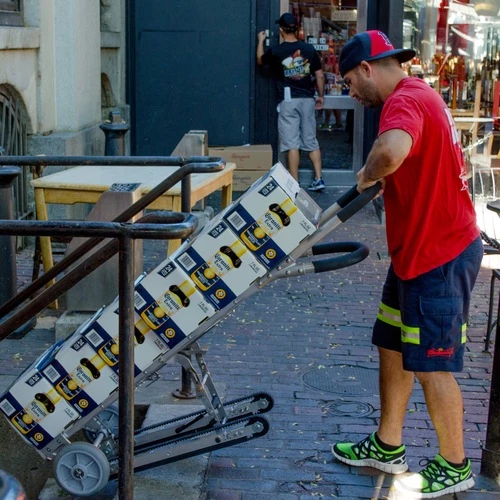For companies delivering kegs and cases of beer to bars, the last leg of the trip, from truck to cellar, is often the most hazardous. Loading kegs onto hand trucks and thumping them down flights of stairs can lead to injury of the workers and damage to the hand truck, stairs and cargo. In response, an engineering team from MIT developed Glyde, a hand truck that scales stairs easily thanks to tank-like treads and a self-braking system.
Similar tread systems have shown up in wheelchairs and suitcases, but Glyde is designed specifically for carting heavy loads down stairs. At the pull of a handle, the treads fold down from the back on an angle. The rubber belts grip each step, and since the mechanism is long enough to span two stairs at a time, the truck remains stable and level the whole way down.
"[The tread means] they're not bouncing over every single step," says John Reynolds, CEO of the startup behind Glyde, ELL Operations (ELLO). "It's that jolting down that breaks the body over time."
As an additional safety measure, the Glyde has a self-braking system built in, which automatically applies braking shoes to the tread's axles when the unit starts moving too fast. With the treads adding some length to the whole thing, a longer handle was needed to allow the driver to comfortably guide the truck from behind. "This puts all the weight on the driver's legs, which reduces back strain," says Reynolds.
Tasked with designing a product with commercial potential, Reynolds and a few classmates invented Glyde back in 2012 as part of MIT's product design class, Course 2.009. Rigorous research and testing followed, involving electrodes attached to delivery drivers as they used existing hand trucks and the early Glyde prototype. The team found that its invention resulted in eight times less muscle strain.

With industry interest coming in, the team started ELLO to commercialize the product, forming partnerships with beverage company Anheuser Busch InBev and hand truck manufacturer Magliner to get Glydes into the hands of the people it's designed for.
"The biggest hurdle we struggled with was driver adoption," Reynolds says. "The mentality of a driver is to get the drive done as quickly as possible without any regard for safety. The driver needs to feel that [a new technology] is fast and makes the day easier, otherwise they won't use it."
After 10 iterations of the design, including a key step that reduced the unfolding of the treads down to about two seconds, the Glyde was released commercially in April. It's currently available for sale from ELLO, and it's demonstrated in the video below.
Source: MIT




